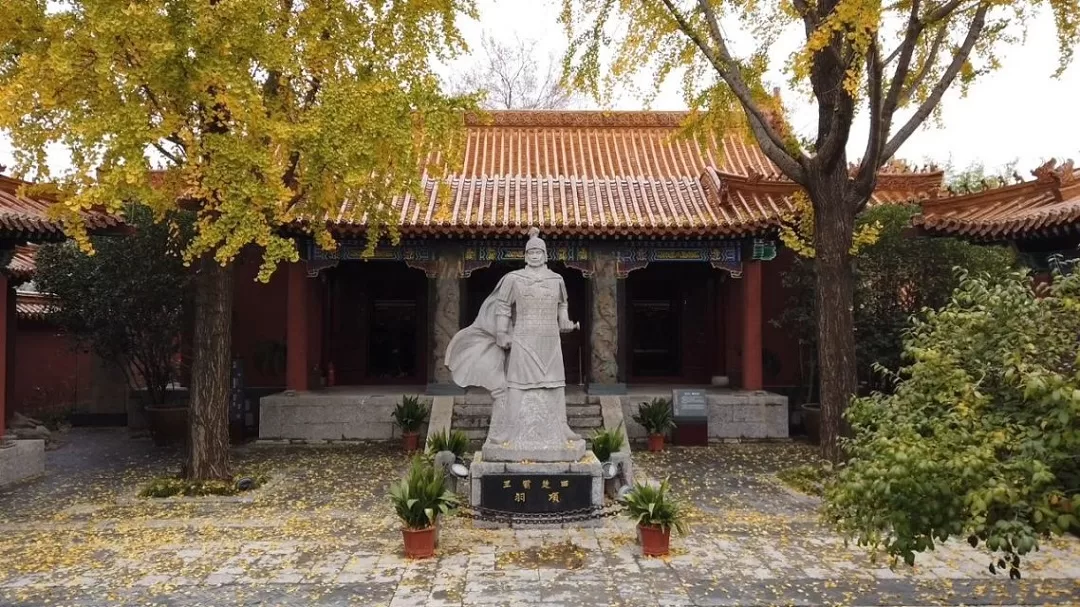Horse-Training Terrace (戏马台 or Ximatai), located atop Hushan Mountain in the central district of Xuzhou, stand as one of the earliest surviving relics in the city. Its historical roots trace back to 206 BCE when the renowned hero Xiang Yu, post the overthrow of the Qin Dynasty, declared himself the Hegemon-King of Western Chu and established the capital in Pengcheng, known today as Xuzhou. Positioned on the southern mountain, it earned the name Ximatai (Horse-Training Terrace), with “xi” denoting play, “ma” for horse, and “tai” for terrace. This elevated site served as a vantage point for observing horse performances, martial arts displays, and military parades.
Throughout history, various dynasties constructed numerous buildings on the grounds of Horse-Training Terrace, including Taitou Temple, Sanyi Temple, Ming Huan Temple, Jukui Academy, Songcui Mountain Villa, and Beiting Pavilion. Unfortunately, the ravages of time led to the gradual disappearance of these structures. However, in the 1980s, the efforts of the gardening authorities resulted in the reconstruction of Horse-Training Terrace into a complex of antique-style buildings modeled after Qing Dynasty officials’ residences, welcoming visitors from both near and far.
Table of Contents
- Basic Information
- Location and Transportation
- Highlights of Horse-Training Terrace
- Vlog about Horse Training Terrace
- Other Attractions in Hubu Mountain
Basic Information
| Estimated Length of Tour | 1 hour |
| Ticket Price | Free |
| Opening Hours | 9.00 – 17.00; Last admission: 16.30 |
| Telephone Number | 0086-0516-83827740 |
Location and Transportation
Horse-Training Terrace are situated at the highest point of Hushan Mountain in the central district of Xuzhou. The specific address is 1 Xiangwang Road, Yunlong District, Xuzhou City, Jiangsu Province. To get there, you can choose one of the following ways:
Bus: Take bus 19, 20, 39, 51, 62, 65, or 612, get off at Zhongguo Renshou Stop (中国人寿站), and walk about 150 meters to the west.
Metro: The closest metro station to Horse-Training Terrace is Hubushan (户部山). After getting out of the station from Exit 1, walk about 200 meters to the west to reach the attraction.
Highlights of Horse-Training Terrace
Gate Tower and Bronze Tripod
Horse-Training Terrace, nestled amidst the undulating terrain of Hushan Mountain, boast a picturesque and well-organized layout. The entrance, marked by a three-section gate tower, is adorned with a plaque bearing the characters “拔山盖世” (“Overcoming mountains and standing supreme”). Adjacent to the gate, on the elevated east platform, stands a monumental bronze tripod engraved with the words “霸业雄风” (“Dominating achievements and heroic spirit”). This rectangular-shaped tripod, weighing 6.5 tons and measuring 2.25 meters in height, 1.91 meters in length, and 1.51 meters in width, bears an inscription known as the “Ximatai Tripod Inscription,” eulogizing the historical feats of Xiang Yu.
Eastern Courtyard
A stunning arrangement of glazed tile eaves and red walls connects two courtyards on the eastern side, creating an atmosphere of simplicity and elegance. The eastern courtyard, named “楚室生春” (“Chu’s residence brings forth spring”), consists of a corridor, the majestic Xiongfeng Hall, and east and west auxiliary halls. In front of the hall stands a stone sculpture of Xiang Yu, the Hegemon-King of Western Chu, towering at 2.85 meters, donned in armor, and standing firm on a rocky base against the wind. The Xiongfeng Hall, serving as the main hall of the “Chu’s residence brings forth spring” courtyard, features two precious dragon columns supporting the canopy and rafters – a rugged yet lively architectural detail preserved among the Horse-Training Terrace buildings. The rear wall of the Xiongfeng Hall is adorned with a set of “西楚春秋” (“Spring and Autumn of Western Chu”) murals, spanning 14 meters in length and 1.3 meters in height, vividly portraying the heroic and tragic life of Xiang Yu.
Western Courtyard
The western courtyard, known as the “秋风戏马” (“Autumn wind plays with horses”) courtyard, centers around the main hall named the Horse-Playing Hall. Surrounding the hall is a cloister with 24 red pillars, and the four walls feature intricately carved floral windows. The centerpiece of the hall is a screen depicting the “秋风戏马” (“Autumn wind plays with horses”) scene, intricately crafted from 144 differently-sized square and rectangular bricks, measuring 9 meters in length and 2 meters in height. The screen depicts a scene from the Battle of Gaixia, showcasing the tension of the Hongmen Banquet. The west auxiliary hall houses a large mural depicting the poignant farewell between the Hegemon-King and his beloved consort after the defeat at Gaixia.
Monumental Stone Tablet
The monumental stone tablet bearing the name “戏马台” (Horse-Training Terrace) is situated within the multi-eaved hexagonal pavilion called Fengyun Ge at the pinnacle of the platform. Authored by Mo Yuqi, the Right Councillors of the Xuzhou Military and Defense Department during the Ming Dynasty, the characters are characterized by bold and vigorous strokes, preserving the authentic style of the Ming Dynasty. The Chongtai Pavilion, positioned at the summit of Horse-Training Terrace behind Fengyun Pavilion, offers a breathtaking panoramic view of the ancient city, allowing visitors to marvel at the cityscape from an elevated perspective.




